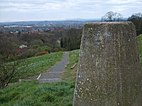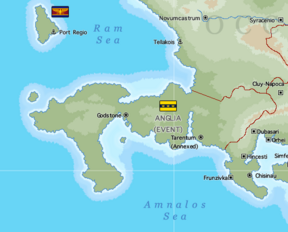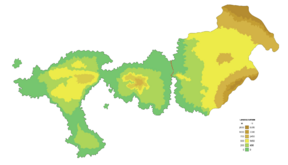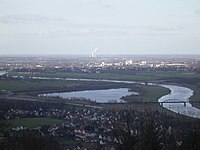Great Anglia
Kingdom of Great Anglia | |
|---|---|
| Capital | Godstone |
| Official languages | Anglic |
| Demonym(s) | Anglian |
| Government | |
• King | Creighton III |
• Prime Minister | Spencer Green |
| Legislature | Parliament |
| Population | |
• 2020 census | 89,434,597 |
| GDP (nominal) | estimate |
• Total | $4.233 Trillion |
• Per capita | $47,330.67 |
| Currency | Anglian Nomisma |
| Time zone | UTC+5 |
| Date format | dd-mm-yyyy |
| Driving side | left |
Great Anglia, or formally the Kingdom of Great Anglia, is a country largely located on the Anglian peninsula in Western Europa (continent) on Eurth. It is bordered by Adaptus to the north, Lysia and Suverina to the east. Great Anglia lies on the coast of both the Ram Sea and the Amnalos Sea, as well as the Adlantic Ocean. Great Anglia is a monarchy, with its capital in the city of Godstone. King Creighton III reigns as monarch since 1997.
Etymology
The name Anglia likely came from the Proto-Argic-Europan root *h₂enǵʰ- (“narrow”), meaning here “the Narrow (Water)”, in reference to Widdeby Sound, the long inlet which runs between the Anglian isthmus and the Amnalos Sea. The root would be *angh- (“tight”). There is also a theory that Anglia meant “hook” (as in: angling for fish), in reference to the shape of the peninsula. It is also possible that the Anglians may have been called such because they were a fishing people or were originally descended from such.
More obscure sources claim the name actually comes from Angelos, and is related to the noble Aroman House of Angelos (ἄγγελος).[citation needed] Some Anglian nobles have used this argument to lay claim to the Leopard Throne of Tagmatium. However, this is not very plausible. The House of Angelos was only founded in the 11th Century. By that time, the name Anglia had already been in use for many centuries.
Geography
Great Anglia is a peninsula comprising of two major sections, Anglia minor in the east and Anglia major in the west. It is bordered by the Ram Sea to the north, the Adlantic Ocean to the west and the Amnalos Sea to the south. Its land borders consist of Suverina to the east and Adaptus to the north. Great Anglia's border with Suverina is roughly delineated by the ($MOUNTAINS), save for the Suverin possession of Cluy-Napoca, which lies on the Anglian side of the same mountain range. Great Anglia's border with Adaptus is altogether less defined, with a portion of the border comprising a straight line from the eastern Anglian highlands to the Ram Sea coast.
Great Anglia is roughly divided in half by Widdeby Sound, a long inlet which separates the peninsula of Anglia-proper from the eastern Anglian regions. West of the Sound, the landscape of Anglia is very flat, with the tallest hill on the peninsula being Hybarrow, standing at 368 metres (1207 feet) above sea level. The eastern regions, however, have a far greater variation in height, roughly sloping from Tarentum in the southwest to the highest points of the ($MOUNTAINS).
History
Prehistory
(WIP. First occupation. Some Pre-Aroman Geltic tribes.)
Classical period
The Anglivarii (or Angrivarii) were an proto-dolchic Occidental people of the early Aroman Empire.[a] They lived in what is now northeast Anglia near the border with Lysia. They built a dike along the Broer river to mark the boundary of their lands. The tribe was first mentioned by the Aroman authors Tákiðos and Ðolemaíos who noted the Angrivarii frequently invaded the borderlands and were expelled by General $AromanPerson. The Anglivarii ware an essential part in defeating the Aromans at the Battle of Teftovoúrgo bridge in the 1st century CE.
Their lands were conquered by Emperor $AromanPerson during the Western Wars in $Year.
WIP
- Links with !Alexandrian and Aroman Empires?
- Did the area have a different foreign name?
- What happens during and after the Aroman disintegration?
- Describe the Christianisation by Saint Lefkopaidos (~300-350). One legend describes how Lefkopaidos started a church in Godstone, and that he lived there until he died in 355. His followers buried his body in the church of Godstone. The impressive tomb is still there. Regardless of this legend, there are doubts whether Lefkopaidos' remains are actually inside the tomb. Examination dates the gravestone slab to the around 13th century.
Post-Aroman dark age
Anglia as an independent power has existed for almost a thousand years. After the collapse of the Aroman power in 484CE after the Battle of Dubaserium, a power vacuum led to several independent duchies and petty kingdoms to arise and vie for power. The former Aroman province of Angliae suffered from extreme instability for decades and suffered one of the few instances in Eurth history of a “reverse colonization” by peoples from Argis.
Around 970 CE, the Geltic peoples from Northern Argis started launching a series of raids around the Occidental region and, finding the Anglian province especially vulnerable, focused much of their efforts on it. By 990 CE, one especially aggressive Geltic lord by the name Arthfael Bricius ($birth-997) launched an ambitious invasion of the country still too fragmented to fully respond. He gained multiple alliances throughout the peninsula and managed to unify the province under one feudal nation. With him, thousands of Geltic descents followed, settling in the southern peninsula of the $ProvinceName province and establishing a Geltic presence for hundreds of years, each of these tribes claiming separate pieces for themselves.
However, this new kingdom was not to last for long as Arthfael Bricius died in 997 which resulted in a fracture. Now the Geltic minority were on the losing side. The ambitious Anglian Duke Godric Ceolmund (958-1049) launched his own campaign by claiming most of Anglia for himself and putting the southern peninsula under siege. By year 999 peace talks began with the original Geltic invaders, Anglia knowing their resistance would prove in vain, bent the knee to a new ruler. King Godric was crowned the same year and ruled for the next fifty years until dying of old age at 91 years old. The foundation for the kingdom he created held firm and would not collapse after his death, solidifying the Kingdom of Anglia in Europa.
For centuries afterwards, Anglia was often in conflict with its Lysian neighbour, and a series of wars, large and small, were fought over claims over the border lands.
War of the Anglian Succession
In 1398 King Albin I died, leaving the throne to his eldest son Edward who became King Edward II. Edward was notably disinterested in his wife, Marie of Lysia, as they were married as a term of the Peace of Fescester. As a result Edward spent much of his time with mistresses, one of whom, whose name is unknown, produced a son for Edward in 1419, and as he had yet to produce a child with his wife, much of the court presumed the son, named Albin for his grandfather, would succeed Edward as King, despite being a bastard. However Edward's brother, Henry, had a son in 1412, also named Edward, who, by Anglian succession law, was the rightful heir to the throne without a proclamation of legitimacy for Albin.
By 1442 Edward II fell ill and wasnt expected to last much longer. Edward, the King's nephew, began making preperations to ascend to the throne, believing that Albin, who was young, inexperienced and illegitimate, would pose little threat to his ascension. In early 1443 Edward II finally succumbed to his illness and died. Edward, who was already in Godstone awaiting his uncle's death, had himself coronated merely days after the previous King's death, and became Edward III. Albin, who was away with an army on the Lysian border, learned of the news of his father's death the day after the coronation, and believed that he was King and that Edward's coronation was an act of treason if not rebellion. Albin gathered the support of the army in the borderlands, and marched them towards Godstone where he intended to seize the throne from Edward. Godstone was host to celebrations and dignitaries when word broke of the advancing army, Edward quickly sent for the western armies to return to defend the capital. Edward also encouraged Lysian dignitaries to come to his defence as he had married the Lysian King's niece Matilda of Coeur, though Lysia was reluctant to make such a move and didnt believe that Albin could muster enough forces to overthrow Edward.
Edward and Albin's armies met first at the Battle of Leetham on the 25th of March, the battle waged for more than a day was a crushing defeat for Edward's forces who were tired after a long journey from the west. Upon hearing news of his defeat, Edward fled Godstone for the west, leaving the capital undefended. Albin's army marched hurredly into Godstone, and when they discovered he had left along with much of the treasury, the city was sacked by Albin's forces which drew public support closer to Edward's cause.
Despite Albin being unpopular among the populace, the nobility and foreign powers, his armies won a series of victories over Edward's forces, forcing him to retreat to the southern tip of the penninsula. By 1444 Edward's situation looked desperate, and he was considering fleeing Anglia altogether. However in July 1444, the Lysian King decided to send troops to support Edward. The Lysian council had become concerned about Albin's ambitions, and feared he would launch an invasion of Lysia to recapture territories. The Lysian armies made a quick advance towards Godstone, and by September the city and surrounding lands were completely within the hands of Edward's cause. Albin's armies scattered to react to the Lysian incursion and soon Edward's armies pushed them further north.
By mid 1445 Albin's army was cornered in the north of the penninsula, and was now facing the combined armies of Lysia and Edward. On June 19th the Battle of Tedorsworth began. Albin's army, in defencive positions, began with small successes in repelling the attackers, however the sheer size of the combined army overwhelmed the forces, and many surrendered or fled the battlefield. Later in the battle Albin decided that he should lead his troops if they were ever going to take victory. Albin was slain, purportedly by Sir Stephen Devondish, in his charge and his corpse was risen to show his troops that their cause was over.
Edward soon returned to the capital of Godstone, and would continue reign until 1472. In return for Lysia's assistance in the war, along with the fact that thousands of Lysian troops were in Anglia at the time, lands along the border were ceded, and Edward would go on to be seen as more a subject of the Lysian crown than an independent ruler.
Ten Years Civil War
In 1534 Duke Harold of $DukedomName ($birth-$death) in southern Anglia raised protest to a series of laws curtailing not only the powers of the nobility but also the Geltic minorities that very much still existed five hundred years after their initial arrival. The ruling monarch King Albin II of Anglia (1499-1565) reacted harshly by declaring Duke Harold an outlaw for betraying the crown. This declaration initiated the beginning of the Anglian Civil War (1534-1543).
Early in the conflict, Duke Harold achieved a series of startling victories against the Anglian royal soldiers. These early victories prompted dozens of Anglian noble lords and dukes to abandon the royal camp and switch sides by joining Harold's side in the conflict. Not soon after the first attack, the Geltic lands in Anglia also pledged their support to Harold as the true ruler of Anglia. The bloody civil war continued to grind on for another six years.
In 1540 the tide began to turn against the beleaguered rebels. King Albin sensing his new upper hand demanded total submission from his rebelious nobility but also the complete annihilation of the Geltic peoples who had dared to rebel against the crown.
The rebels began to discuss amongst themselves on how to best survive their threatened destruction when several cities in their northernmost holdings were put to the sword by the Anglian armies. The decision was made to flee, as they could no longer hold off the overwhelming might of the Anglian forces. Over the next year, in 1541 ships were constructed in haste to begin the mass migration. The Geltic people of Anglia knew of free lands near the Dolch Sea to the southeast of Argis that would be suitable for them to flee to. With their courses set, dozens of ships made the first journey to the island to be known as Seylos. As the Anglians closed in on their remaining port settlements by the end of 1543, the last rebel ships set sail carrying as many people with them to the fabled island as they could. Those that remained were given no quarter by the advancing Anglians.
Early Modern period
WIP
- Medieval period. When did they move out into the Adlantic Ocean?
- Modern period. Link to early modern and modern histories.
21st century
(WIP. In early 2021 begin a series of wars against its neighbours, a conflict known as the 2021 Anglian War.)
Politics
Great Anglia is a unitary state under a constitutional monarchy. King Creighton III of the House of Odell is the monarch and head of state. However, the monarch takes little direct part in governing the country and doesn't make any political decisions. The monarch lacks any formal political power. Legislative power is vested in the bicameral Parliament of Great Anglia, made up of the House of Commons and the House of Lords. The head of government is the prime minister, currently Spencer Green, who selects all the other ministers.[1] During the 21st century, Anglian foreign policy has adopted a revisionist policy of imperialism and militarism. The international 'face' of Great Anglia is the Foreign Minister, Sir Algernon Edgeyton. The Minister of Defence is Lord Douglas Aberfeldy, a distinguished aristocrat and second cousin of the King.[2][b]
The main business of parliament takes place in the two houses of the commons and the lord, but royal assent is required for a bill to become an act of parliament (law). The Prime Minister is typically chosen by the monarch as the leader of the largest party in the commons or lords. The largest party currently is the Union Party, a big-tent grouping of parties, which came together to support the King's expansionist policies.
Economy
Anglia is one of the richest countries in Occidental Europa in terms of gross domestic product (GDP) per capita. This high standard of living is expected by its citizens. Anglia is an export-oriented mixed economy, and one of the largest arms exporters in the wurld. The largest trade flows are with Suverina, Adaptus, Tagmatium, Eidolmanta, and Bashan.
(WIP. What does it make and sell? Who are the trade partners? Currency is the Anglian Nomisma, related to Tagmatine Nomisma.)
Demographics
Language
Great Anglia is a country located on the Anglian Peninsula, which is situated in the western part of the Occidental subcontinent. The country is well-known for its unique culture, particularly its language, Anglish or Anglic. Anglish is a language of Buranian origin, with significant influence from Lysian and Adapton Aromance. It is the primary language spoken by the Anglian people and is used throughout the country, as well as several islands in Argis, Marenesia, and Alharu. Due to its widespread use, Anglish has become a major cultural symbol of Great Anglia. The language of Anglish has evolved over time, reflecting the country's rich cultural history. It is a unique blend of various linguistic influences, which has resulted in a distinct dialect and pronunciation. The grammar and vocabulary of the language have also been influenced by neighbouring languages, particularly Lysian and Adapton Aromance.
Education
The educational system of Great Anglia is a comprehensive and structured system that provides compulsory education to children from the ages of 5 to 17 years old. Education in Great Anglia is highly valued, with a majority of children being educated in public schools. The primary education system in Great Anglia is divided into two main stages: primary education and secondary education. Primary education begins at the age of 5 and lasts for 6 years, while secondary education lasts for 7 years and begins at age 11. Upon completion of secondary education, students are required to take an examination to determine their eligibility for higher education.
In Great Anglia, public schools are the primary mode of education for most children. These schools are funded by the government and are free for all students. Public schools are known for their high standards of education and their focus on providing a well-rounded curriculum that includes not only academic subjects, but also sports and extracurricular activities. In addition to public schools, there are also private schools in Great Anglia. These schools charge tuition fees and are often attended by students from affluent families. Private schools are known for their high standards of education and their focus on providing a more specialized curriculum, typically with a greater emphasis on academic subjects.
The first institution of higher education and research in Great Anglia was the University of Stancaster, which received its royal charter in 1694. The university is one of the oldest and most prestigious universities in the country, and is known for its academic excellence and research facilities. Today, there are many other universities in Great Anglia that offer a wide range of undergraduate and graduate degree programs.
Culture
Great Anglia shares strong cultural and historic ties with its Occidental neighbours Lysia, Suverina and Adaptus.
Arts
In addition to its unique language, Great Anglia has a rich cultural heritage that is reflected in its music, dance, and art. The country's traditional music is known for its use of stringed instruments and percussion, and is often accompanied by dance. Many of the country's folk dances have been passed down through generations, and are still performed at cultural festivals and events.
Great Anglia also has a long history of art, with many famous artists and painters hailing from the country. The country's art is known for its vibrant colours and intricate designs, which frequently depict scenes from nature and mythology.
Cuisine
Great Anglia's cuisine is heavily influenced by the country's agricultural heritage, with dishes featuring locally grown produce and meats. The country's rich farmland has allowed for the cultivation of a variety of fruits and vegetables, including apples, potatoes, and carrots, which are staples in many of the country's traditional dishes.
One of the most popular dishes in Great Anglia is roast lamb, which is typically slow-roasted and served with a variety of vegetables and a mint sauce. The dish has become a symbol of the country's agricultural heritage, and is often served during festive occasions and celebrations.
Another iconic dish in Great Anglia is fish and chips, which has become a staple in the country's cuisine. The dish consists of battered and fried fish, typically cod or haddock, served with thick-cut fries and a side of mushy peas. Fish and chips are enjoyed at seaside towns and are popular takeaway food.
Shepherd's pie is another classic dish in Great Anglia, and is typically served as a hearty and comforting meal during the colder months. The dish typically consists of minced lamb or beef, topped with mashed potatoes and baked in the oven until golden and crispy.
In addition to these popular dishes, Great Anglia's cuisine also includes a variety of soups, stews, and baked goods, including meat pies, pasties, and scones. Many of these dishes have been passed down through generations, and are proof of the country's rich culinary history.
Notes
- ↑ OOC. In a rather funny coincidence, there exists an actual region called Angria, or "Angry Anglia".
- ↑ OOC. The character 'Lord Aberfeldy' was an alias for Ian Munro, a British MI19 agent during World War II. See also: BBC News, The Nazi prisoners bugged by Germans (18 January 2013).
References
- ↑ The Gallambrian, Anglia may invade Bashan. What's at stake for Gallambria? (28 January 2022)
- ↑ Exercise Vigilant Twilight (31 October 2022)


















